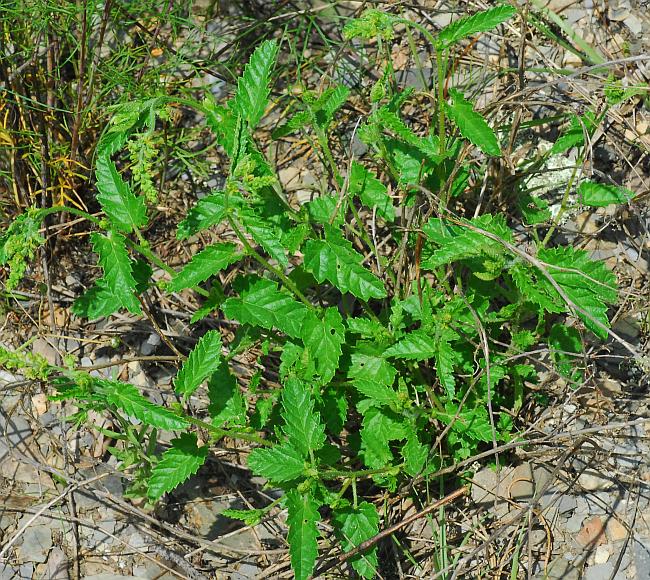Tragia betonicifolia Nutt.
Noseburn

Native
CC = 4
CW = 5
MOC = 41
© SRTurner
Tragia betonicifolia Nutt.Noseburn | |
 |
Native CC = 4 CW = 5 MOC = 41 |
© SRTurner |
|
Family - Euphorbiaceae Habit - Perennial forb, monoecious, usually with a woody vertical rootstock, with clear sap, variously pubescent with shorter, unbranched, nonglandular hairs and at least some longer, needlelike, stinging hairs. Stems - Prostrate to ascending, to 40 cm, one to several, not twining in adjacent vegetation, pubescent with moderate short, straight to curved, softer, nonstinging hairs and sparse to moderate longer, stiff, spreading, stinging hairs.
Leaves - Alternate, simple, petiolate. Stipules somewhat leaflike, 2-5 mm long. Leaf blades 1-5 cm long, lanceolate to ovate-triangular, rounded, truncate, or cordate at the base, rounded or more commonly angled to a sharply or occasionally bluntly pointed tip, pinnately veined, the surfaces pubescent with usually sparse nonstinging hairs and sparse to moderate stinging hairs, the margins sharply toothed.
Inflorescences - Lateral and opposite the leaves, slender racemes with 1-2 pistillate flower(s) at the base below 14-75 staminate nodes.
Flowers - Staminate flowers with the bract 1-2 mm long; the flower stalk 0.7- 1.0 mm long, the persistent lower portion 0.3-0.6 mm long; the calyx 3-5-lobed, 1.2-2.3 mm long; the stamens usually 3. Pistillate flowers with the bract 1.5-2.0 mm long; the flower stalk 0.7-1.0 mm long at flowering, elongating to 3-4 mm long at fruiting; the calyx 6-lobed, 1.5-3.0 mm long at flowering (longer than the pistil), enlarging to 3-5 mm long at fruiting. Ovary usually with 3 locules and 1 ovule per locule, the styles fused in the lower 1/3-1/2, the stigmas papillose, not further lobed or branched. Corollas absent.
Fruits - Capsules, 3-lobed, 4-5 mm long, 7-9 mm in diameter, moderately pubescent with mostly stinging hairs, violently dehiscent. Seeds nearly spherical, 3-4 mm long, smooth, yellowish brown to brown, sometimes mottled.
Flowering - June - September. Habitat - Glades, prairies, bluffs, dry upland forest openings, fields, pastures, railroads, roadsides. Origin - Native to the U.S. Lookalikes - T. ramosa, which is much less common in Missouri. Other info. - This little species is found in the southern half of Missouri, predominantly in southwestern counties. Missouri populations represent the extreme northeastern extent of the plant's range, which is mostly contained within six states to the south and west of Missouri. The plant can be identified by its lanceolate, toothed leaves and monoecious inflorescences. Its leaves tend to be larger and more tapered than those of T. ramosa. Be careful when handling this species as it can inflict some serious pain. Photographs taken at the Pea Ridge National Military Park, AR., 8-12-03 (DETenaglia); also at Drury-Mincy Conservation Area, Taney County, MO, 4-14-2012 and 5-1-2012, Lake of the Ozarks SP, Camden County, MO, 6-3-2012, and in the Ouachita National Forest, Montgomery County, AR, 5-7-2015, and St. Joe State Park, St. Francois County, MO, 7-11-2025 (SRTurner). |